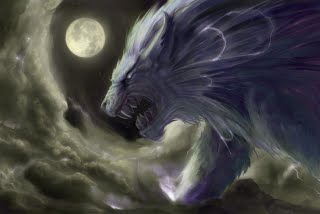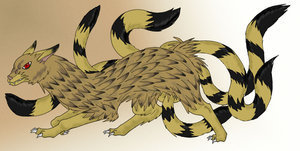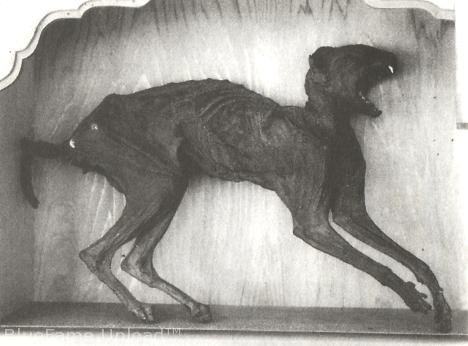Raijū
Posted by: Loren Coleman on September 8th, 2009
The Raijū
by Brent Swancer
Since the dawn of time, humans have looked to the skies with a sense of wonder and fascination. The wind, the sky, clouds, thunder and lighting, these things have always captured the imagination and held a certain mystical quality. Since long before the age of science, human beings have looked to the heavens and sought to explain these phenomena, to find some way to grasp how they fit into the universe that they know.
In Japan, thunder and lightning were the elements of the Raijū, or literally “thunder beast,” the mighty servants of the Shinto god of thunder. These creatures were most often described as looking something like a badger, weasel, cat, or fox, although they were sometimes said to look like a wolf or monkey as well. Some accounts speak of the creatures having wings, or having multiple tails. They are quite often depicted as being wreathed in crackling lightning, and their voices were the boom of thunder. Raijū were said to descend to the earth upon lightning bolts, ride atop lighting, or to travel about in hovering balls of lightning. During storms, these creatures would become very agitated, frantically dashing about and leaping from tree to tree, tearing up the bark in the process with their formidable claws. In Japanese folklore, it was said that trees scored by lighting had been the work of Raijū claws.
With all of this fierce and dramatic imagery surrounding Raijū, it is perhaps no wonder that people feared and respected these otherworldly creatures. It did not help that these thunder beasts were thought to be fond of swooping down from trees to bite and slash at passerby. During storms, people avoided hiding under trees, where it was believed the Raijū were most active and likely to attack. It was said that one of the favorite targets of Raijū was the navel, which prompted many to protect their stomach or lie face down during stormy weather. Yet for all of the menace they projected, Raijū were thought to be unable to pass through mosquito nets, and also to abhor the smell of burning incense.
Japan has a long history of stories concerning these strange entities falling from the sky, and a few reports even tell of them being killed and eaten by farmers. There are additionally many accounts of these fallen Raijū actually being captured alive.
One such account concerns a Raijū that was captured in the 18th century on Mt. Asama, Shimane prefecture. This specimen was then kept in an iron net and put on display for all to see. Most onlookers described the animal as looking like something between a fox and a weasel, and possessing sharp, curved claws. The creature refused to eat or drink during its captivity, and would become extremely agitated before the evening rain. During stormy weather, its hair would stand on end and it would emit a high pitched, shrieking noise.
Another such creature was captured in the fiefdom of Lord Nagai, in the Iwatsuki ward of Saitama prefecture. The Raijū was allegedly caught while tearing through a garden and damaging vegetables in the aftermath of a storm. Upon its capture, the creature was kept for a time in a cage before it died from refusing to eat or drink. The animal was reported to have the unusual appearance of a puppy with the claws of a bear. The feet were described as having many knuckles, and the pelt was thin except for thicker fur beneath the legs.
One Raijū allegedly fell into a well in Izumo province, where it became hopelessly entangled in ropes and was captured alive. The creature was subsequently exhibited within a cage of brass in the court of the temple of Tenjin, in Matsue city. The animal was said to resemble a badger. When the weather was clear, the Raijū was quite docile, sleeping quietly in its cage most of the time. However, during storms it would become a ferocious, hissing beast, and its eyes were said to flicker and flash as if filled with lightning.
A farmer captured yet another Raijū in 1766, when one fell from the sky in Oyama in the Sagami province. The farmer showed the animal for money on the Riyo-goku bridge. It was described as black in color, a little larger than a cat, and having the appearance of a weasel. Each of the creature’s paws was adorned with five prominent, vicious looking claws. Similarly to the other captured Raijū described so far, this specimen was also tame during calm weather, yet savage during storms, during which it would furiously rattle and claw at its cage. It also refused any food given to it.
In addition to live Raijū, there are many alleged mummies of these creatures kept in locations around Japan. One such mummy is kept at Yuzanji temple in Iwate prefecture. The mummy looks very much like a cat, only with longer legs and no discernible eye sockets. It was allegedly received in the 1960s as a donation from a parishioner, although the exact origin of the mummy is not known.
Another similar looking Raijū mummy is kept at Saishoji temple in Niigata prefecture. The sacred nature of these artifacts makes any DNA testing unlikely, however there is a very good possibility they are examples of elaborate gaffes, or creative taxidermy.
The accounts of creatures riding balls of lightning or crashing to the ground upon lightning bolts may understandably make many skeptical of the existence of a creature like the Raijū. With such fantastical elements, it may appear as though these are beasts from the depths of human imagination rather than from the sky. At the very least it seems obvious that accounts of these creatures have been embellished and imbued with folkloric elements. However, is it possible that somewhere at the heart of this folklore, there might be a zoological explanation for the Raijū?
Certainly the ancient Japanese, like those of many cultures throughout the world, would have looked upon natural phenomena such as storms with a sense of curiosity and awe. Lacking an understanding of science, they may have tried to explain these things with such supernatural tales of divine thunder beasts sent down from the skies. Many known animals in Japan have been linked in folklore with a wide range of natural phenomena. Perhaps with the Raijū we have something that similarly started as a real animal, that became associated with storms and lightning through an attempt to come to grips with these forces, and thus became entrenched in mythological lore. It might have started with something as simple as someone seeing a tree struck by lightning and the animals in question running for cover, which might have given the impression that these creatures had fallen down in a bolt from above. Tales of the Raijū flying within spheres of lightning may have been an attempt to explain ball lightning in the context of an animal they knew about. Could the Raijū have been a real animal seen though the lens of superstition concerning the power and mystery of nature?
Indeed, if one strips away the more outlandish elements such as riding lightning or flying in balls of plasma, we are left with something that seems consistent with a flesh and blood animal.
What animal could possibly account for such outlandish stories? We will explore the answer to this question and more in Part 2. Stay tuned!
About Loren Coleman
Loren Coleman is one of the world’s leading cryptozoologists, some say “the” leading living cryptozoologist. Certainly, he is acknowledged as the current living American researcher and writer who has most popularized cryptozoology in the late 20th and early 21st centuries.
Starting his fieldwork and investigations in 1960, after traveling and trekking extensively in pursuit of cryptozoological mysteries, Coleman began writing to share his experiences in 1969. An honorary member of Ivan T. Sanderson’s Society for the Investigation of the Unexplained in the 1970s, Coleman has been bestowed with similar honorary memberships of the North Idaho College Cryptozoology Club in 1983, and in subsequent years, that of the British Columbia Scientific Cryptozoology Club, CryptoSafari International, and other international organizations. He was also a Life Member and Benefactor of the International Society of Cryptozoology (now-defunct).
Loren Coleman’s daily blog, as a member of the Cryptomundo Team, served as an ongoing avenue of communication for the ever-growing body of cryptozoo news from 2005 through 2013. He returned as an infrequent contributor beginning Halloween week of 2015.
Coleman is the founder in 2003, and current director of the International Cryptozoology Museum in Portland, Maine.















This article was great, Brent (via Loren). Thanks for sharing. I’m always interested to hear about Japanese folklore/mythology! 😀
Awesome Brent! Thank you!
This is just what I needed after a week of mange ridden coydogs and lamp post arguments. (Also, I now have a better understanding of why the fox demon in Jade Empire has multiple tails.)
Great post, as always, Brent. 🙂
Looking forward to the follow-up.
This is why I like some “Eastern” cryptids more than the “Western” ones.
Very interesting, as always. Makes me wonder how much if any overlap there is wit the legends of the Kitsune. They too have the multiple tail element as I recall.
Those Mummified animals don’t look known. unless they’re mutated known animals. as for all the tails, it would be a amazing find if these animals were born with more then 2 tails naturally. i wonder if they’re hybrids
They both look like cats or an animal of lynx qualities to me.
Though it may be the influence of that picture at the top messing with my head, I get a very strong ‘binturong’ feeling from everything except the mummies. (I feel like those look like cats, myself.) Almost certainly, a binturong that far north would be a new species. It also seems that it has several distinguishing qualities, if fairly minor ones. For one, longer claws, though those of a binturong are already fairly sizable. Also, the behavioral qualities of extreme agression during storms and not eating in captivity are quite dissimilar to the sole known species of binturong.